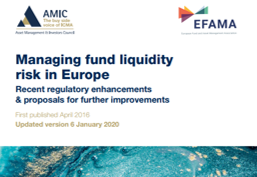EU Fund regulation
The EU fund product landscape is deep, diverse and dynamic. Since the birth of the UCITS framework in 1985, European institutions have progressively refined it into a global “gold standard”, one that successfully balances strict regulatory requirements with the flexibility required by manager to meet evolving client demands. The successful evolution of UCITS was followed by the creation of alternative investment funds (AIFs) under the 2011 AIFM Directive, adding a second important pillar to EU fund/manager regulation. Building on this second pillar are further ambitious EU fund products, such as EUSEFs, EUVECAs and ELTIFs. EFAMA has helped guide all of these key regulatory developments, informing policymakers and regulators on their main merits and drawbacks, while also keeping a close eye on their respective review initiatives.
EFAMA strongly supports a fundamental review to the ELTIF regime, in view of broadening its eligible investment universe and adapting it to better meet retail investor needs. We are also closely monitoring the review of the AIFM Directive from a product regulation standpoint, including possible spillover effects on the UCITS Directive requirements. Further work involves keeping pace with relevant ESMA initiatives, such as the work around the Common Supervisory Action on costs and fees for UCITS.
EFAMA's response to ESMA's CP on Implementing technical Standards under Regulation (EU) 2019/1156
Counterparty and liquidity risks in ETFs - EFAMA response to ECB
Our comment paper confutes the ECB study’s main findings by focusing on its two core areas, namely
liquidity and counterparty risks inherent to the structure and functioning of ETFs. A final section
considers the merits of further regulatory action addressed at the European ETF industry.
EFAMA’s comments on ESMA’s CP on Draft regulatory technical standards under Article 25 of ELTIF Regulation
European Statistics Q4 2020 | 2020 Trends | Inflows into UCITS and AIFs bring European fund assets to an all-time high
The European Fund and Asset Management Association (EFAMA) has today published its Investment Fund Industry Fact Sheet for Q4 of 2020, together with an overview of the full year.
The main developments through the quarter are as follows:
Monthly Statistics December 2020 | UCITS and AIF ended 2020 with record net sales in December
The European Fund and Asset Management Association (EFAMA) has published its Investment Fund Industry Fact Sheet for December together with an overview of the net sales data for UCITS and AIFs in 2020.
Thomas Tilley, Senior Economist, commented on the December figures: “Net sales of UCITS and AIFs surged to an absolute record in December 2020, as investor confidence in a successful exit from the Covid-19 crisis continued to strengthen.”
The main developments in December are as follows:
European Alternative Fund Managers Directive stands the test of time
The European Fund and Asset Management Association (EFAMA) has published today its response to the European Commissions public consultation on the review of the Alternative Investment Fund Managers Directive (AIFMD).
Annual Review June 2019-June 2020
"It gives me great pleasure to provide you with an overview of our activities since our Annual General Meeting in Paris last year. While we were very much looking forward to hosting you all in Brussels this week, the current crisis and associated travel restrictions has forced us to improvise and turn our meeting into a virtual AGM.
EFAMA Market Insights | Issue #1 | Net outflows from UCITS in March 2020 - Industry weathers Covid-19 crisis
The Covid-19 pandemic significantly impacted financial markets. Stock markets across the world suffered a steep decline driven by lower economic growth and corporate profits. As anticipated, the crisis caused substantial net outflows from UCITS in March (EUR 313 billion). However, as a percentage of net assets, these outflows were no higher than in October 2008, at the height of the global financial crisis (2.9%).
AMIC EFAMA Report - Managing fund liquidity risk in Europe - 2020
In 2019, AMIC and EFAMA decided to update their 2016 report “Managing Fund Liquidity Risk in Europe” following important policy and regulatory developments at EU and international levels. The purpose of this updated report is to outline the practical liquidity risk management processes which fund management companies put in place when setting up a fund and implement throughout the life of the fund. Also, the report describes the existing European and international regulatory frameworks in the area of fund liquidity risk management.


































